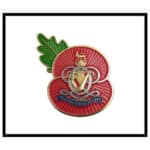The Silver War Badge was issued in the United Kingdom to service personnel who had been honourably discharged due to wounds or sickness during World War I.
The badge, sometimes known as the Discharge Badge, Wound Badge or Services Rendered Badge, was first issued in September 1916, along with an official certificate of entitlement.
After April 1918 the eligibility was amended to include civilians serving with the Royal Army Medical Corps, female nurses, staff and aid workers.
The sterling silver lapel badge was intended to be worn in civilian clothes. It had been the practice of some women to present white feathers to apparently able-bodied young men who were not wearing the King’s uniform. The badge was to be worn on the right breast while in civilian dress, it was forbidden to wear it on a military uniform.
The badge bears the royal cypher of GRI (for Georgius Rex Imperator; George, King and Emperor) and around the rim “For King and Empire; Services Rendered”. Each badge was uniquely numbered on the reverse, although this number is not related to the recipient’s Service Number.
The War Office made it known that they would not replace Silver War Badges if they went missing, however, if one was handed into a police station then it would be returned to the War Office. If the original recipient could be traced at his or her discharge address then the badge would be returned.
There were about 1,150,000 Silver War Badges issued in total for service during the First World War service. The issue of badges effectively ceased on 31 December 1919, with no man who was discharged after that date being eligible for a badge.



